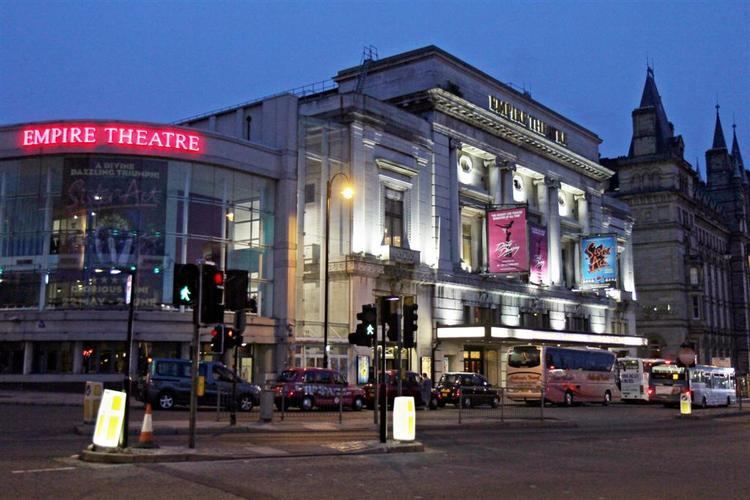Type Theatre Groundbreaking 1924 Capacity 2,350 Phone +44 151 702 7320 | Country England Completed 1925 Opened 9 March 1925 Owner Ambassador Theatre Group | |
 | ||
Address Lime St, Liverpool L1 1JE, UK Profiles | ||
Liverpool Empire Theatre is a theatre located on the corner of Lime Street and London Road in Liverpool, Merseyside, England. The theatre is the second to be built on the site, and was opened in 1925. It has the largest two-tier auditorium in Britain and can seat 2,348 people. During its time it has hosted many types of entertainment, including variety shows, musicals, operas, pop concerts, and plays. The Beatles appeared in the theatre in their early days. The theatre has hosted two Royal Command Performances and in 2007, a Royal Variety Performance to mark Liverpool's being designated a European City of Culture the following year. It is sited in the William Brown Street Conservation Area.
Contents
History
The first theatre on the site opened on 15 October 1866 and was named the "New Prince of Wales Theatre and Opera House". It was at that time Liverpool's largest theatre. On 29 July 1867 its name was changed to the "Royal Alexandra Theatre and Opera House" in honour of Princess Alexandra, Princess of Wales. The theatre closed in 1894, but was re-opened the following year under the ownership of Empire Theatre (Liverpool) Ltd. In 1896 the theatre was sold to Messrs. Moss and Thornton for £30,000 (equivalent to £3,130,000 in 2015), and renamed "The Empire". This theatre closed on 16 February 1924, and it was demolished.
It was replaced by the present larger theatre, which opened on 9 March 1925. In 1977 the theatre was still owned by Moss Empires, who were making plans to dispose of it. Two years later it was acquired by Merseyside County Council. During the following two years a total of £680,000 was spent on improving the back stage facilities, and extending the stage and orchestra pit. The theatre underwent a further major refurbishment in 1999; this included increasing the size of the stage and improving the facilities for the audience. By 2002 the theatre was owned by Clear Channel Entertainment. In that year an extension was built on the north side of the building.
Exterior
The theatre was designed by W. and T. R. Milburn for Moss Empires; the carving and the ornamentation in the auditorium were carried out by E. 0. Griffiths. The building is constructed on a steel frame, with a Portland stone façade and brick elsewhere. The architectural style of the façade is free Neoclassical. The front of the theatre is in five bays, the central three of which have an attic rising above the two lateral bays. The ground floor of the central bays contains the entrance doors and over them is a steel canopy decorated with medallions and guilloché bands. The storey above ground level contains the balcony, with single and paired Ionic columns, between which are recessed windows. Over this is a dentilled cornice and the attic. In the first floor of the side bays there are windows in architraves that are flanked by shallow pilasters above which is a plain parapet.
Interior
The entrance foyer is on the ground level, with stairs to the balcony on both sides of the foyer. The seats are raked both to the sides and to the rear in order to improve the lines of sight. The internal decoration is in Louis XVI style. It contains "many curious decorative features including carved elephant caryatids".
Assessment
The theatre is recorded in the National Heritage List for England as a Grade II listed building, having been designated on 16 October 1990. When it was opened its design was considered advanced, owing to the raked seating layout. There are 2,350 seats, Britain's largest two-tier auditorium. It is sited in the William Brown Street Conservation Area.
Past performances
Performers in the original theatre included George Formby, Sr., Harry Tate, Dan Leno, Florrie Forde, The Two Bobs, and Wilson, Keppel and Betty. The first production in the present theatre was Better Days, starring Stanley Lupino, Maisie Gay and Ruth French. Subsequent performers have included Frank Sinatra, Judy Garland, Bing Crosby, Mae West, Laurel and Hardy, Roy Rogers and Trigger, Charlton Heston, Sarah Bernhardt, Henry Irving, Vesta Tilley, and Arthur Askey. More recent artists include Johnny Mathis, The Carpenters, Neil Sedaka, The Osmonds, Tommy Steel, Adam Faith, Bruce Forsyth, Victoria Wood, Morecambe and Wise, Ken Dodd, Shirley Bassey, Kate Bush, Elton John, Cilla Black, The Shadows (1989). In 1957 a local pop group called The Quarrymen appeared at the theatre. They returned in 1959, having changed their name to "Johnny and the Moondogs". They returned to the Empire again in 1962, now named The Beatles. The Beatles played the Empire for the last time on 5 December 1965. During the 1970s two Royal Command Performances were held in the Empire, and in 2007 the theatre was the venue for the Royal Variety Performance in recognition of Liverpool being made the European Capital of Culture for the following year.
Present day
The Empire Theatre continues to stage productions in various genres, including musicals, pop concerts, comedians, plays, opera, and wrestling. The theatre is reputed to be haunted by at least two ghosts, one a former painter at the theatre called Len, the other a girl aged about nine or ten in Victorian dress. As of 2011 the Empire is part of the Ambassador Theatre Group (ATG).
Each year a musical is produced at the theatre performed by participants in Stage Experience, a two-week summer school in which local youngsters take part in performing a full-scale musical with a professional team. This began in 2007 with Summer Holiday, followed by The Wiz in 2008, Bugsy Malone in 2009, Fame in 2010, West Side Story in 2011, Annie in 2012, Grease in 2013, Cats in 2014, and Rent in 2017.
